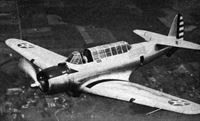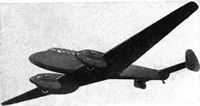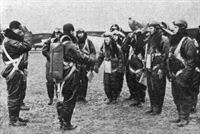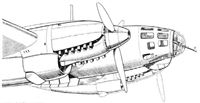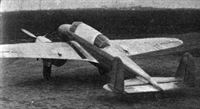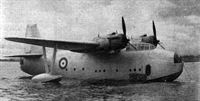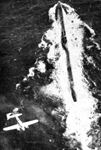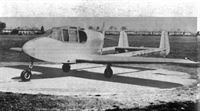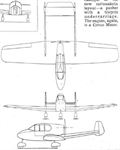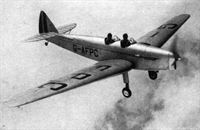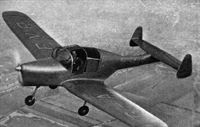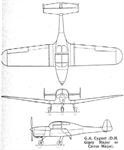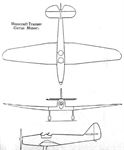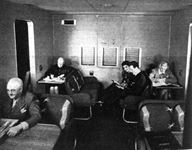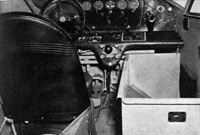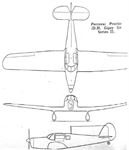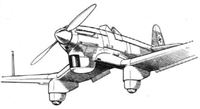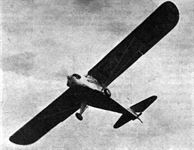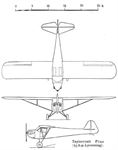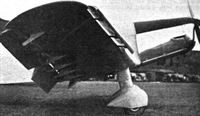Фотографии
-
Bf 109 стал самым массовым в истории авиации истребителем - построено более 33 000 самолетов. На фотографии - Bf 109C-1.
A Messerschmitt Bf 109 single-seater fighter. This machine is said to have fine flying qualities and is fitted with Handley Page slots and flaps. This machine may not be as formidable as many people believe but is certainly not so bad as others are trying to make out. The type shown is the earlier version.Самолёты на фотографии: Messerschmitt Bf.109 / Bf.109B / Bf.109C / Bf.109D - Германия - 1935
-
MESSERSCHMITT BF 109. A single-seater fighter widely employed in the Luftwaffe, the Bf 109 is fitted with a Daimler-Benz or Junkers engine. The type commonly in use is believed to be inferior in performance and armament to the Supermarine Spitfire. Some of these machines are believed to be fitted with shell-guns of 23 mm. calibre.
Самолёты на фотографии: Messerschmitt Bf.109 / Bf.109B / Bf.109C / Bf.109D - Германия - 1935
-
GETTING READY FOR ACTION. Refuelling Bristol Blenheims.
Самолёты на фотографии: Bristol Blenheim - Великобритания - 1936
-
Ready for action. Fighter pilots receive final instructions.
Самолёты на фотографии: Bristol Blenheim - Великобритания - 1936
-
Calling-in at Buffalo Airport for a visit to the Curtiss Wright Airplane Division. Picture taken by the author from a D.C.3.
Самолёты на фотографии: Douglas DC-3 / C-47 Skytrain/С-53 Skytrooper / Dakota - США - 1935
-
DORNIER 215. This machine bears the same relation to the Do 17 as does the modified Heinkel to the original He 111. The crew is grouped together in the redesigned nose to the rear of which is a downward-firing machine gun.
Самолёты на фотографии: Dornier Do.17Z / Do.215 - Германия - 1939
-
Самолёты на фотографии: Heinkel He-111P/H - Германия - 1938
-
A symbolic view of a fly-past of Heinkel bombers (modified He 111 K type) during the parade before Herr Hitler at Charlottenburg on April 20 this year.
Самолёты на фотографии: Heinkel He-111P/H - Германия - 1938
-
Вот такие солдаты-разгильдяи охраняли самолеты на аэродромах
A recent picture ot one of the short-nosed Heinkel He 111s being refuelled during manoeuvres. The motor which drives the fuel pump is in the tent on the left.Самолёты на фотографии: Heinkel He-111P/H - Германия - 1938
-
The photograph purports to show the pilot of an He 111 giving a rendering on his mouth organ of the Horst Wessel song as he flies along in formation.
Самолёты на фотографии: Heinkel He-111P/H - Германия - 1938
-
Details of the nose gun mounting of the latest type of He 111 may be studied in the view. The gun is of the standard German pattern and is belt fed from a peculiar magazine which saddles the breech portion.
Самолёты на фотографии: Heinkel He-111P/H - Германия - 1938
-
A specially prepared Flight drawing showing details of the latest type of Heinkel He 111 bomber. The machine shown has Daimler Benz DB 601 direct-injection engines.
Самолёты на фотографии: Heinkel He-111P/H - Германия - 1938
-
HEINKEL HE 111K (Modified). Compared with its predecessor this model has a redesigned nose which is almost entirely transparent, and a “permanent” lower gun position which might also be used for observation purposes. The engines are Daimler-Benz DB 601s or Junkers Jumo 211s.
Самолёты на фотографии: Heinkel He-111P/H - Германия - 1938
-
HEINKEL HE 112U. Developed from the Heinkel He 112, which is now some years old, this fighter is probably the fastest in service with the Luftwaffe. It bears a certain relationship to a machine used by Germany to break the world’s speed record.
Самолёты на фотографии: Heinkel He-112 - Германия - 1935
-
HENSCHEL HS 126. Used tor observation and short-range reconnaissance, this B.M.W.-powered machine is employed in large numbers by the German Air Force. Two or three machine guns and a light bomb load can be carried.
Самолёты на фотографии: Henschel Hs 126 - Германия - 1936
-
FORMIDABLE opponents. The unusually high speed and exceptional manoeuvrability of Hawker Hurricane fighters make em powerful weapons of defence. Fitted with Rolls-Royce Merlin engines they form the equipment of many fighter squadrons.
Самолёты на фотографии: Hawker Hurricane - Великобритания - 1935
-
Hawker Hurricane single-seater fighters being groomed for action.
Самолёты на фотографии: Hawker Hurricane - Великобритания - 1935
-
ALLIED EQUIPMENT: A Potez 63 multi-purpose monoplane as used in large numbers by l'Armee de I'Air. The two bulges below the fuselage are fairings for 20 mm. Hispano shell-guns.
The fairings for the twin 20 mm. Hispano shell-guns ara visible below the fuselage in the view below of a Potez 63 fighter. The machine illustrated has Hispano-Suiza engines.Самолёты на фотографии: Potez Potez 63 - Франция - 1936
-
Третья неделя войны - "Спитфайры" на дежурстве
Spitfire fighters standing by, awaiting the signal.Самолёты на фотографии: Supermarine Spitfire - Великобритания - 1936
-
The new 1,600 h.p. Pratt and Whitney Double Wasp installed in a Vultee YA-19 bomber. As this particular engine is without the extension shaft, the spinner is not needed.
Самолёты на фотографии: Vultee V-11 - США - 1935
-
Henschel Hs 123 single-seater dive-bombers of the Luftwaffe. It will be seen that these machines are carrying their long-range fuel tanks though no bombs are fitted.
Самолёты на фотографии: Henschel Hs 123 - Германия - 1935
-
A study ot the Henschel Hs 123 single-seater dive-bomber biplane as used extensively by the Luftwaffe. Bombs are carried beneath the wings; the streamlined object beneath the fuselage is a fuel tank.
Самолёты на фотографии: Henschel Hs 123 - Германия - 1935
-
HENSCHEL HS 123. A sturdy biplane capable of functioning as a single-seater fighter or dive-bomber this aircraft is normally fitted with a B.M.W. radial. Like the Blohm and Voss monoplane it carries two or four machine guns.
Самолёты на фотографии: Henschel Hs 123 - Германия - 1935
-
MESSERSCHMITT BF 110. A new twin-engined fighter-bomber fitted with Daimler-Benz or Junkers liquid-cooled engines this machine, for which great things are claimed, can be armed with two 23 mm. shell-guns and a number of large-bore machine guns. The top speed is said to be in the region of 350 m.p.h. though it may well be more.
Самолёты на фотографии: Messerschmitt Bf.110 - Германия - 1936
-
A flight of the original type of Ju 87 dive-bombers. This version has the 650 h.p. Junkers Jumo 210 engine and a comparatively poor performance.
Самолёты на фотографии: Junkers Ju.87 - Германия - 1935
-
A 500 kg. (1,100 lb.) bomb photographed a moment after release from one of the earlier Ju 87s.
Самолёты на фотографии: Junkers Ju.87 - Германия - 1935
-
"Bombing up" a squadron of Ju 87s at Kitzingen-on-Main aerodrome. The machines are of the earlier type with trousered undercarriage.
Самолёты на фотографии: Junkers Ju.87 - Германия - 1935
-
A Junkers Ju 87 after a test flight at the Dessau aerodrome.
Самолёты на фотографии: Junkers Ju.87B - Германия - 1938
-
The view shows a Ju 87 on exhibition at Brussels this year. The stowage of the smaller bombs is visible in the view.
Самолёты на фотографии: Junkers Ju.87B - Германия - 1938
-
Июнь 41-го: немецкий пилот пикирует на город
The view must be almost unique in that it was taken from the rear cockpit of a dive-bomber, actually a German Junkers Ju.87, during a vertical dive.Самолёты на фотографии: Junkers Ju.87B - Германия - 1938
-
JUNKERS JU 87. Employed as a specialised dive-bomber carrying a single 500 kg. or 1,000 kg. bomb, the Ju 87 is fitted with small air brakes just aft of the leading edge. These limit the speed during a bombing dive and permit a closer approach to the target.
Самолёты на фотографии: Junkers Ju.87B - Германия - 1938
-
This Flight copyright drawing reveals in great detail the equipment, armament and structure of the latest type Junkers Ju 87 dive-bomber. The engine is a petrol injection junkers Jumo 211, giving a take-off output of 1,200 h.p. The method of lowering the main bomb on arms, to ensure that it clears the airscrew arc after a diving release, is indicated, and the leading edges of the wings are cut away to show the diving brakes which are in the down position.
Самолёты на фотографии: Junkers Ju.87B - Германия - 1938
-
A "G.P." AT THE SALON. The Polish P.Z.L. 23 monoplane is a bombing and reconnoitring type, or what we should know as a general-purpose machine. Upper and lower rear gun positions are included and the maximum speed with one of the new Gnome Rhone 14N-01 engines (950 h.p. at 12,460 ft.) is claimed to be 230 m.p.h.
Самолёты на фотографии: PZL P.23 / P.43 Karas - Польша - 1934
-
PZL-37Abis польских ВВС
Another view of the Los, showing the fine fuselage entry with its abundance of transparent panelling. The cowlings of the Pegasus engines are of unusual formation and the four-wheeled undercarriage is another unorthodox feature.Самолёты на фотографии: PZL P.37 Los - Польша - 1936
-
Pilot’s of the Polish Air Force before departing in their Los bombers. It would appear that their personal equipment, like their flying material, is of good quality. Points to note are the padded helmets and the Irvin parachute harness (including back type).
Самолёты на фотографии: PZL P.37 Los - Польша - 1936
-
OUT EAST: Despite preoccupation with the activities of the Royal Air Force comparatively near home we shall not forget the units overseas. Here is a Westland Lysander co-operating with the ground forces in the desert.
Самолёты на фотографии: Westland Lysander - Великобритания - 1936
-
Heinkel He 111s of the Luftwaffe seen on arrival in Prague last March. At this time Field Marshal Goering announced the formation of a new air command based on Vienna.
Самолёты на фотографии: Heinkel He-111 - Германия - 1935
-
The sketch shows the nose and engine installation ot one of the earlier type He 111s (DB 600 engines).
Самолёты на фотографии: Heinkel He-111 - Германия - 1935
-
HEINKEL HE 111K. Like its derivative type this twin-engined bomber should be capable of speeds approaching 300 m.p.h. There is a machine gun in the nose, another on top of the fuselage and a third in a retractable "dustbin."
Самолёты на фотографии: Heinkel He-111 - Германия - 1935
-
The view illustrates a DB 601 installation in a recent machine and the inset shows the appearance of a Jumo 211 nacelle.
Самолёты на фотографии: Heinkel He-111 - Германия - 1935
-
Powered with two Foka engines of about 450 h.p. each this neat little twin-engined fighter-dive-bomber is known as the Wilk.
Самолёты на фотографии: PZL P.38 Wilk - Польша - 1938
-
Based on the design of the Westland Lysander the P.Z.L. Mewa (Gnome-Rhone M.14) is a standard army co-operation type.
Самолёты на фотографии: LWS LWS-3 Mewa - Польша - 1937
-
Регистрационный номер: L8338 Although not often seen at clubs, the Miles Magister is one of the standard R.A.F. training types and particularly suited for primary work before passing on to modern types.
Самолёты на фотографии: Miles Magister / M.14 - Великобритания - 1937
-
Very complete instrument duplication is a feature of the Miles Magister Trainer. The control on the right, matching the throttle on the left, is that for fore and aft trim.
Самолёты на фотографии: Miles Magister / M.14 - Великобритания - 1937
-
Miles Magister (D.H. Gipsy Major).
Самолёты на фотографии: Miles Magister / M.14 - Великобритания - 1937
-
ARADO AR 95. Produced as a landplane or seaplane, this model can be used for torpedo dropping, bombing, reconnaissance, smoke-screen laying, etc. It also functions as a dive bomber and is, in fact, comparable with our T.S.R.s.
Самолёты на фотографии: Arado Ar.95 - Германия - 1936
-
Nothing to do with the subjects discussed by "Indicator," but Connor Park aerodrome, Australia, with a portion of the town of Rockhampton in the background. It is the mid-way stopping place between Brisbane and rich north-west. Airlines of Australia run a daily service each way with Stinson Trimotors. One of the two Dragons belongs to Aircraft Pty. and is used for carrying Sunday newspapers from Brisbane. The D.H.86 belongs to W. R. Carpenter and was, when the picture was taken, on its way from New Guinea to Sydney. The Monospar belongs to Air Taxis,while the Moth is owned by the Rockhampton branch of the Royal Queensland Aero Club.
Самолёты на фотографии: De Havilland Dragon / D.H.84 - Великобритания - 1932De Havilland Express Air Liner / D.H.86 - Великобритания - 1934De Havilland Moth / D.H.60 - Великобритания - 1925General Aircraft Monospar ST-25 Universal - Великобритания - 1935
-
Регистрационный номер: G-AFDP Demonstrating the new C.40 Autogiro from suitably impossible country. In this photograph the machine has just left the ground from a point beside that where the spectator is standing.
Самолёты на фотографии: Cierva C.40 - Великобритания - 1938
-
DORNIER DO 17. A well-established type, shown here with Daimler-Benz engines, the Do 17 carries three machine guns and has a top speed in the neighbourhood of 285 m.p.h. Earlier versions were powered with B.M.W. VI engines and the type has also been produced with radials, including the Bramo Fafnir.
Самолёты на фотографии: Dornier Do.17 - Германия - 1934
-
Самолёты на фотографии: Vickers Wellington / Type 271 - Великобритания - 1936
-
JUNKERS JU 86K. Powered with Junkers Jumo diesels (as shown) or B.M.W. radials, this machine is now regarded as obsolescent. Its performance is inferior to that of the Heinkels and Dorniers though Junkers have lately been producing Ju 88 bombers which are said to be very fast indeed.
Самолёты на фотографии: Junkers Ju.86 - Германия - 1934
-
EMPIRE DEFENCE: One of the new Saunders-Roe Lerwick long-range flying boats (two Bristol Hercules) which will be used for oversea reconnaisance, patrol and bombing. The Lerwick is amongst the fastest flying boats in the world and is exceptionally well defended.
Самолёты на фотографии: Saunders-Roe Lerwick / S.36 - Великобритания - 1938
-
The ship’s lifeboat approaches one of the flying boats, which has alighted, white the other flying boat keeps watch from the air.
Самолёты на фотографии: Short Sunderland / S.25 - Великобритания - 1937
-
Sinking of SS Kensington Court by a German U-boat on September 18, 1939.
One of the two flying boats circling the Kensington Court, looking for the submarine, while the ship’s lifeboat is rowed towards the other flying boat.Самолёты на фотографии: Short Sunderland / S.25 - Великобритания - 1937
-
DORNIER DO 18K. Two Junkers diesel engines give this machine an unusually long range, though the performance is quite low as indicated by the fact that the machine guns are installed on unprotected manually operated mountings.
Самолёты на фотографии: Dornier Do.18 - Германия - 1935
-
HEINKEL HE 115. A comparatively new twin-engined floatplane. This aircraft is normally fitted with B.M.W. radials and can be used for torpedo dropping, bombing and reconnaissance. It is not merely a seaplane version of the bombers illustrated on the opposite page.
Самолёты на фотографии: Heinkel He-115 - Германия - 1937
-
The author and Mr. Jimmy Taylor inspect the latter’s Fleetwing Seabird amphibian.
Самолёты на фотографии: Grumman G-21/JRF/OA-9/OA-13 Goose - США - 1937
-
ANTI-SUBMARINE: Modern oversea reconnaissance aircraft acting in conjunction with Naval vessels are a strong deterrent to underwater craft operating within range of their aerodrome. Carrying special anti-submarine bombs they can patrol waters where submarines may be lurking, spot them and complete their destruction.
Самолёты на фотографии: Avro Anson / Type 652 - Великобритания - 1935
-
RETURNING HOME: Avro Ansons cross the coast line after finishing an anti-submarine patrol.
Avro Anson general reconnaissance machines (actually belonging to the Coast Artillery Co-operation Unit) head inland after “a job of work.”Самолёты на фотографии: Avro Anson / Type 652 - Великобритания - 1935
-
DIVE-BOMBERS: Blackburn Skua I fleet-fighter dive-bombers of the Fleet Air Arm.
Самолёты на фотографии: Blackburn Skua / B-24 - Великобритания - 1937
-
A COURAGEOUS CAMEO. A scene which may be witnessed scores of times during a working day in Courageous
A Fairey Swordfish approaching to alight on the Courageous. Note the escorting destroyer.Самолёты на фотографии: Fairey Swordfish - Великобритания - 1934
-
In spite of the fact that the Tipsy is a side-by-side seater the lines are very clean and there are no unnecessary projections or etceteras. Seated as they are over the main spar, both the pilot and the passenger (or instructor) have a really useful field of view.
Самолёты на фотографии: Tipsy B / BC - Бельгия - 1937
-
Tipsy Two-seater, 62 h.p. Walter Mikron II.
Самолёты на фотографии: Tipsy B / BC - Бельгия - 1937
-
Регистрационный номер: G-AFGB The Arpin A-1 tricycle pusher in its latest form in 1939 with a 90 h.p. Blackburn Cirrus Minor I, re-positioned pitot head, new nose and static mass balances on rudders and ailerons.
Самолёты на фотографии: Arpin A-1 - Великобритания - 1938
-
The Arpin, an example of the new rationalistic layout - a pusher with a tricycle undercarriage. The engine, again, is a Cirrus Minor.
Самолёты на фотографии: Arpin A-1 - Великобритания - 1938
-
Регистрационный номер: G-AFSV With the 44 h.p. Train engine the little Chilton single-seater is even tidier than the Ford-engined prototype.
Самолёты на фотографии: Chilton D.W.1 - Великобритания - 1937
-
Регистрационный номер: G-AFPC Moth Successor: The new D.H. Moth Minor, which is an inexpensive machine for touring and training. It is normally flown from the front seat.
Самолёты на фотографии: De Havilland Moth Minor / D.H.94 - Великобритания - 1937
-
Регистрационный номер: G-AFVR The G.A. Cygnet in its production form. Notice the way in which the roof-"half" slides back.
Самолёты на фотографии: General Aircraft Cygnet II / GAL.42 - Великобритания - 1939
-
G. A. Cygnet (D.H. Gipsy Major).
Самолёты на фотографии: General Aircraft Cygnet II / GAL.42 - Великобритания - 1939
-
Регистрационный номер: G-AFMS The Mosscraft in its latest trainer form, with the split flaps in the "down" position. It has a Cirrus Minor engine.
Самолёты на фотографии: Mosscraft MA-1 / MA-2 - Великобритания - 1937
-
Mosscraft Trainer (Cirrus Minor).
Самолёты на фотографии: Mosscraft MA-1 / MA-2 - Великобритания - 1937
-
Регистрационный номер: VH-ABL The Percival Q.6 in retractable undercarriage form. This particular machine was one for Australia.
Самолёты на фотографии: Percival Petrel / Q.6 - Великобритания - 1937
-
Регистрационный номер: G-AEKL Самолёты на фотографии: Percival Mew Gull - Великобритания - 1934
-
A normal layout of ths Vega Gull showing the ample door width and seating arrangement.
Самолёты на фотографии: Percival Vega Gull / K.1 - Великобритания - 1935
-
Регистрационный номер: G-AFKK Internal and external finish have been given special attention in the new Wicko, which is a side-by-side two-seater cabin monoplane.
Самолёты на фотографии: Foster Wikner Wicko - Великобритания - 1936
-
Wicko (D.H. Gipsy Major).
Самолёты на фотографии: Foster Wikner Wicko - Великобритания - 1936
-
Регистрационный номер: D-OEHF The Heinkel He 270, a shapely two-seater, which may or may not have passed into service.
Самолёты на фотографии: Heinkel He-270 - Германия - 1938
-
“The comfort, not to say luxury, of the internal arrangements of the Dixie Clipper must be seen to be believed.”
Самолёты на фотографии: Boeing Boeing 314 Clipper - США - 1938
-
Регистрационный номер: NC18100 "I also found a division of opinion on the operation of so-called ‘giant aircraft,’ such as the D.C.4."
Самолёты на фотографии: Douglas DC-4E - США - 1938
-
Регистрационный номер: NC21109 A standard Stinson Reliant of All-American Aviation, Inc., picking up a mail container at a small town which has no aerodrome
Самолёты на фотографии: Stinson Reliant - США - 1933
-
The mail bin on the right-hand side of the cockpit has a capacity of 250 lb. The aeroplanes are provided with two-way radio.
Самолёты на фотографии: Stinson Reliant - США - 1933
-
Percival Proctor (D.H. Gipsy Six Series II).
Самолёты на фотографии: Percival Proctor / P.28 - Великобритания - 1939
-
The new Fairchild trainer, which is a tandem-seater low-wing monoplane.
Самолёты на фотографии: Fairchild PT-19 / PT-23 / PT-26 Cornell - США - 1939
-
Регистрационный номер: G-AFPP The Piper Cub is now being produced in 65 h.p. form. This is the 50 h.p. Coupe.
Самолёты на фотографии: Piper Cub J-3/J-4 / L-4 Grasshopper / PA-11 - США - 1937
-
With 65 h.p., the latest Chief has a useful performance as a floatplane. This one, owned by Mr. H. B. Chapman, was actually the first to be produced.
Самолёты на фотографии: Aeronca K Scout / KM Chief - США - 1937
-
Регистрационный номер: D-IFOE The little Blohm and Voss Ha 137 with Junkers Jumo 210 engine is a single-seater dive bomber with flaps to reduce its diving speed.
Like the Junkers Ju 87, the single-seater Ha 137 (type B) has cranked wings which improve the pilot’s view. The engine is a 650 h.p. Junkers Jumo 210.Самолёты на фотографии: Blohm und Voss Ha.136 / Ha.137 - Германия - 1934
-
The nose of an early type Blohm and Voss Ha 137 single-seater dive-bomber.
Самолёты на фотографии: Blohm und Voss Ha.136 / Ha.137 - Германия - 1934
-
BLOHM AND VOSS HA 137. It is not definitely known that this single-seater fighter-dive-bomber is in squadron use. The original machines, at least, were fitted with an early type of Junkers inverted vee-twelve engine and were quite slow.
Самолёты на фотографии: Blohm und Voss Ha.136 / Ha.137 - Германия - 1934
-
The wing of the Ha 137 is built round a single tubular spar following standard Blohm and Voss practice. The spar is of chrome molybdenum steel and duralumin.
Самолёты на фотографии: Blohm und Voss Ha.136 / Ha.137 - Германия - 1934
-
Регистрационный номер: G-AFMU Normally flown from the front, the Luton Major has a tandem-seater cabin.
Самолёты на фотографии: Luton Major - Великобритания - 1939
-
A G.A. drawing of the Luton Major, which may be considered as being the logical development of the single-seater Minor. This cabin machine, in which the occupants sit in tandem, should be flying within a few weeks.
The preliminary specification and performance figures are: - All-up weight, 1,030 lb.; weight empty, 600 lb.; maximum speed, 100 m.p.h.; cruising speed, 85 m.p.h.; stalling speed, 30 m.p.h.; and cruising range, 320 miles. The provisional price, in fully equipped form, is £525.Самолёты на фотографии: Luton Major - Великобритания - 1939
-
The Sum, which was developed from the P.Z.L. P.23 general-purpose machine. Machine use a Pegasus engine and are very heavily armed.
Самолёты на фотографии: PZL P.46 Sum - Польша - 1938
-
JUNKERS JU 89. This large bomber or bomber-transport is structurally similar to the Ju 90 transport aircraft which was frequently seen at Croydon prior to declaration of war.
Самолёты на фотографии: Junkers Ju.89 - Германия - 1936
-
The simple and conventional lines of the Taylorcraft are obvious in this flying view. The separate trimming surface may just be seen below the elevators.
Самолёты на фотографии: Taylorcraft A / B / C / F-19 / F-21 / F-22 - США - 1937
-
Taylorcraft Plus (55 h.p. Lycoming).
Самолёты на фотографии: Taylorcraft A / B / C / F-19 / F-21 / F-22 - США - 1937
-
The Hillson Helvellyn which should be flying very shortly. It is interesting largely because it is of mid-wing design. The engine is a Cirrus Minor.
Самолёты на фотографии: Hillson Helvelynn - Великобритания - 1939
-
The slots, flaps and ailerons of the new Parnall trainer. Both flaps and ailerons are slotted.
Самолёты на фотографии: Parnall Model 382 / Heck III - Великобритания - 1939
-
The prototype 382 in the air. Notice that it is being flown solo from the front seat.
Самолёты на фотографии: Parnall Model 382 / Heck III - Великобритания - 1939
-
The Millichamp pusher monoplane, with a tricycle undercarriage, as it will appear when completed. The prototype will be fitted with a 70 h.p. Salmson AD.9.R. engine.
Самолёты на фотографии: Millichamp pusher - Великобритания - 1939
-
Регистрационный номер: NC19131 "One of the most interesting developments I found in aircraft structures was the Clark cabin monoplane, powered by a 450 h.p. Ranger engine."
Самолёты на фотографии: Fairchild 46-A - США - 1937
Статьи
- Flight
- Flight Advertisements



















